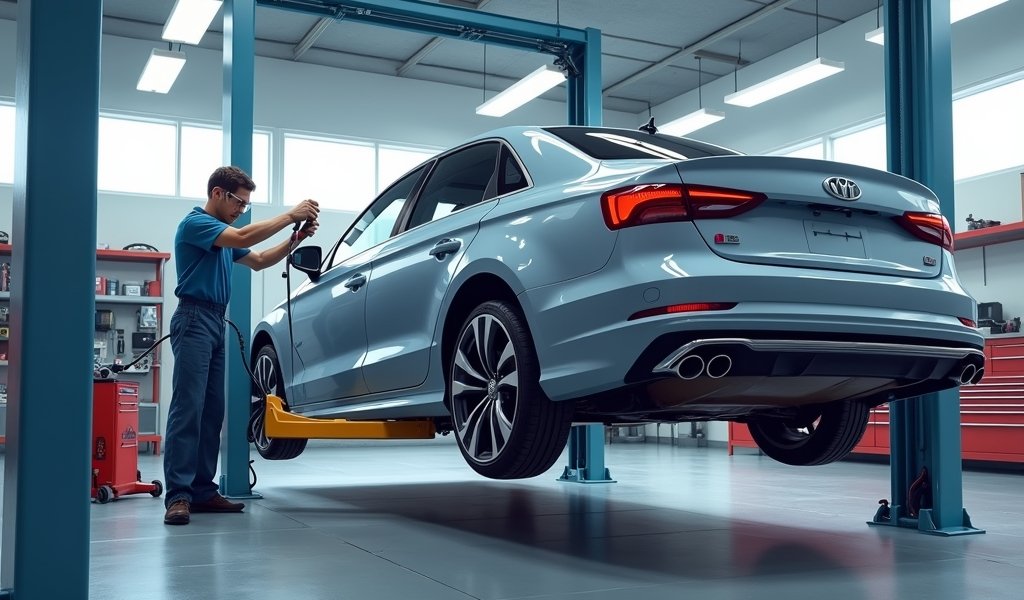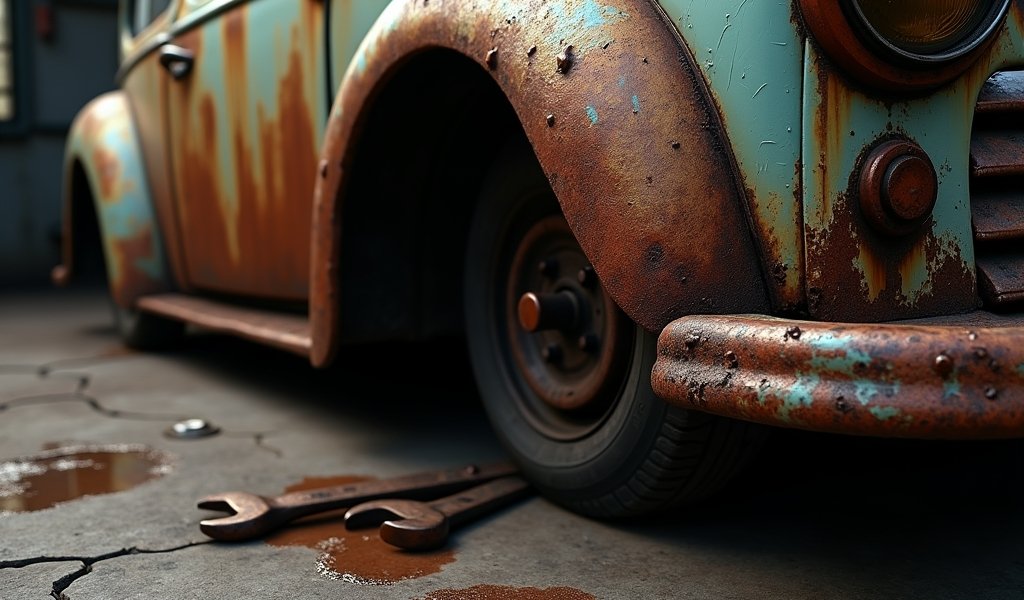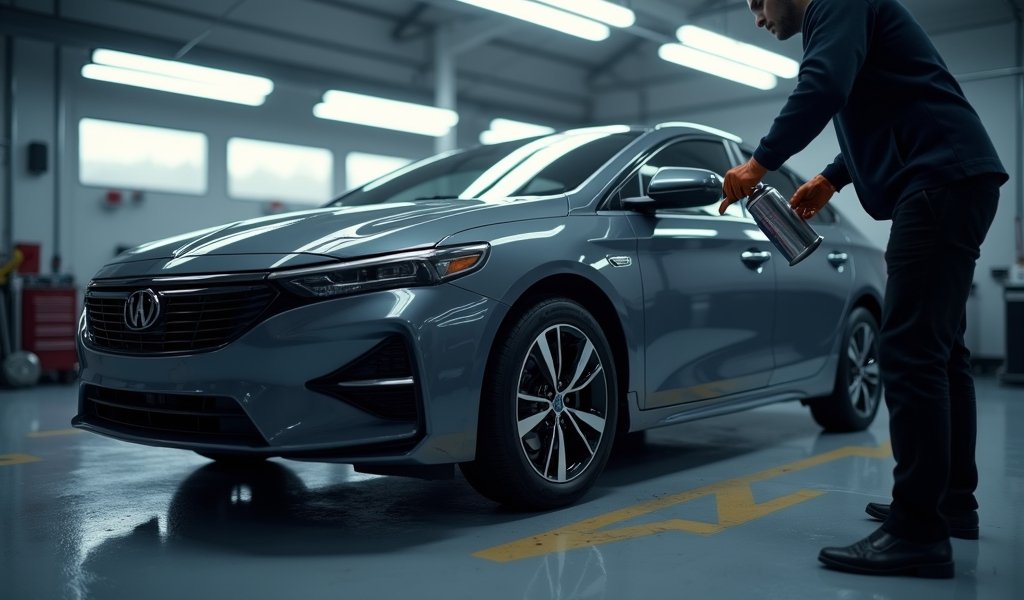Overview
This article outlines seven essential rust prevention methods for vehicles, including regular washing, waxing, undercoating, cavity wax treatment, proper storage, immediate repair of paint damage, and using rust inhibitors on vulnerable areas. The author emphasizes that consistent implementation of these practices can significantly extend a vehicle’s life, preserve its structural integrity, and maintain its value by preventing rust formation in both visible and hidden areas.
Table of Contents
- Understanding Car Rust: The Silent Car Killer
- 1. Regular Washing: Your First Line of Defense
- 2. Waxing: Creating a Protective Shield
- 3. Undercoating: Armor for Your Vehicle’s Underside
- 4. Cavity Wax Treatment: Protecting the Hidden Spaces
- 5. Proper Storage: Shelter from the Elements
- 6. Addressing Chips and Scratches: Quick Action Required
- 7. Rust Inhibitor Products: Extra Protection for Vulnerable Areas
- Conclusion: Keeping Rust at Bay for the Long Haul
- Frequently Asked Questions
Understanding Car Rust: The Silent Car Killer
I’ve spent 20 years under the hood, and I can tell you this with certainty: rust is your vehicle’s silent killer. That first tiny orange speck might seem harmless, but it’s the beginning of a process that can reduce your car’s value by up to 30% and compromise its structural integrity.
In my garage, I’ve seen too many vehicles meet an early grave because of advanced rust damage that could have been prevented. The frustrating truth? Most rust issues are completely avoidable with proper preventative care.
Rust forms when iron-containing metals encounter oxygen and moisture – a simple chemical reaction with devastating consequences. This process accelerates dramatically when exposed to:
- Road salt and de-icing chemicals (the worst offenders)
- Coastal air with high salt content
- Persistent humidity and rainfall
- Industrial pollutants
- Damage to protective paint layers
Your vehicle’s most vulnerable areas include wheel wells, undercarriage components, door bottoms, rocker panels, and areas around windows where water can collect. These spots demand special attention in your rust prevention strategy.
The good news is that with some consistent care, you can significantly extend your vehicle’s life. Let’s dive into the seven proven methods I recommend to my own customers.
1. Regular Washing: Your First Line of Defense

The simplest rust prevention method is often the most overlooked: regular washing. This isn’t about vanity – it’s about removing corrosive substances before they can damage your vehicle.
Road salt is particularly destructive. When dissolved in water, it creates an electrolyte solution that essentially turns your car’s metal surfaces into a weak battery, dramatically accelerating the corrosion process. One winter of neglect can lead to years of rust problems.
For maximum protection, I recommend:
- Washing your vehicle every 10-14 days during winter or in coastal areas
- Choosing car washes with underbody spray options (crucial for salt removal)
- Paying special attention to wheel wells and rocker panels
- Using a pressure washer to flush out hidden areas where salt collects
- Ensuring your vehicle dries thoroughly after washing (trapped moisture accelerates rust)
If temperatures hover below freezing, look for heated indoor wash facilities. The few extra dollars spent on quality car washing now will save you hundreds or thousands in rust repairs later.
After particularly heavy exposure to road salt or after driving through flooded areas, don’t delay – get your vehicle washed as soon as possible. I’ve seen significant rust develop within days under the right (or rather, wrong) conditions.
2. Waxing: Creating a Protective Shield
Think of waxing as creating an invisible shield between your car’s paint and the elements. A quality wax job doesn’t just make your car shine – it actively repels water and contaminants that would otherwise reach the metal beneath.
In my shop, I recommend waxing every three months for most drivers. If you live in harsh environments (coastal areas, heavy winter road salt regions), consider increasing to every two months for maximum protection.
For optimal rust prevention:
- Choose a high-quality carnauba or synthetic polymer wax
- Apply wax after thorough washing and drying
- Pay special attention to edges, seams, and areas prone to water accumulation
- Don’t forget door jambs and other semi-hidden areas
The wax’s hydrophobic properties create a barrier that water beads up on rather than penetrating to reach the metal beneath. This simple layer of protection can prevent years of potential rust damage, especially in areas where the paint might be thinner from normal wear.
For those looking for longer-lasting protection, ceramic coatings provide exceptional water repellency for up to several years, though they require professional application and represent a higher initial investment. For most drivers, regular waxing provides an excellent balance of protection and cost-effectiveness.
3. Undercoating: Armor for Your Vehicle’s Underside
The underside of your vehicle takes the worst beating from road debris, moisture, and salt spray, yet it’s the area most owners neglect. Undercoating adds a critical layer of protection to these vulnerable components.
I’ve seen dramatic differences in vehicles that receive regular undercoating treatment versus those that don’t – often adding years to a vehicle’s usable life. This is especially important for trucks and SUVs that might see off-road use.
When considering undercoating options:
- Oil-based undercoatings (like Fluid Film or Woolwax) penetrate deeply and self-heal minor scratches but require annual reapplication
- Rubberized coatings create a thicker barrier but must be applied perfectly to avoid trapping moisture
- Electronic rust inhibitors show mixed results in my experience – I generally recommend physical barriers
For DIY application, expect to pay $50-150 for materials. Professional application typically runs $150-500 depending on vehicle size and the product used. According to Consumer Reports’ research on rust protection, annual treatment is one of the most cost-effective ways to extend vehicle life in rust-prone regions.
If budget is a concern, focus first on protecting the most vulnerable areas: brake lines, fuel lines, and structural components. Even partial protection is significantly better than none.
4. Cavity Wax Treatment: Protecting the Hidden Spaces
While visible surfaces get most attention, rust often begins its assault in hidden cavities within doors, pillars, and frame rails. These enclosed spaces trap moisture for extended periods, creating perfect breeding grounds for corrosion.
Cavity wax is specifically designed to penetrate these hard-to-reach areas, displacing moisture and creating a protective barrier. It’s like sending reinforcements to the most vulnerable parts of your vehicle’s defense system.
For effective cavity protection:
- Use products specifically designed for penetration (Fluid Film, CRC Marine Corrosion Inhibitor)
- Apply using specialized wands with 360-degree nozzles
- Access through factory drainage holes or by removing plastic plugs
- Focus on door internals, rocker panels, and structural pillars
This treatment should ideally be done annually before winter begins. Many seasonal maintenance routines overlook this crucial step, but in my decades of experience, it makes a substantial difference in long-term rust prevention.
If you’re restoring an older vehicle, cavity wax becomes even more critical as factory seals deteriorate with age. I’ve saved numerous classic cars by implementing aggressive cavity protection even after initial rust had begun.
5. Proper Storage: Shelter from the Elements

How and where you store your vehicle significantly impacts its susceptibility to rust. This is especially true for seasonal vehicles or those that aren’t driven daily.
Ideal storage conditions include:
- A clean, dry garage with concrete flooring
- Good air circulation to prevent moisture buildup
- Moderate humidity (40-50% is ideal)
- Protection from temperature extremes
If indoor storage isn’t available, consider these alternatives:
- Use a high-quality, breathable car cover (avoid non-breathable materials that trap moisture)
- Park on paved surfaces rather than grass or dirt
- Consider a portable carport for additional protection
- Use desiccant packs inside the vehicle if stored long-term
For vehicles stored longer than a month, I always suggest disconnecting the battery and using a trickle charger. This prevents potential electrical system corrosion while maintaining battery health.
According to Hagerty’s vehicle storage guidelines, proper storage can be the single most significant factor in preventing rust in collector vehicles. Even daily drivers benefit from thoughtful parking choices when not in use.
6. Addressing Chips and Scratches: Quick Action Required
In my years as a mechanic, I’ve seen how quickly neglected paint damage can evolve into serious rust problems. Even minor chips create entry points for moisture to reach the metal beneath, making immediate repair essential.
When you notice paint damage:
- Clean the area thoroughly with isopropyl alcohol
- Apply touch-up paint matching your vehicle’s color code
- Allow proper drying between coats
- Consider clear coat for additional protection
- Buff lightly if needed for smooth integration
For chips smaller than a pencil eraser, dealer touch-up paint works well. For larger damage, consider professional repair, especially if bare metal is exposed. I’ve seen quarter-sized chips develop into palm-sized rust spots in just one harsh winter when left untreated.
Keep a touch-up pen in your glove box for immediate temporary protection until proper repairs can be made. Think of paint as your vehicle’s skin – when it’s broken, infection (rust) can quickly set in if not treated promptly.
During winter maintenance preparation, take time to inspect your entire vehicle for paint damage, paying special attention to front-facing surfaces that take the brunt of road debris.
7. Rust Inhibitor Products: Extra Protection for Vulnerable Areas
Beyond the basics, specialized rust inhibitors provide an additional defensive layer, especially for vehicles in harsh environments. These products are particularly valuable for older vehicles or those already showing early signs of corrosion.
Effective rust inhibitors work by:
- Displacing moisture on metal surfaces
- Creating a protective film that blocks oxygen contact
- Neutralizing corrosive substances already present
- Penetrating tiny crevices where moisture hides
In my shop, I’ve had excellent results with products like Fluid Film, CRC Marine Corrosion Inhibitor, and POR-15 for different applications. Each serves specific purposes in a comprehensive rust prevention strategy.
Focus application on high-risk areas:
- Door hinges and latches
- Suspension components
- Battery terminals and electrical connections
- Areas where different metals meet (galvanic corrosion risk)
For maximum effectiveness, apply these products after thorough cleaning and drying. Most require reapplication every 6-12 months, with more frequent treatment in severe environments.
Remember that rust inhibitors complement rather than replace the other prevention methods we’ve discussed. They’re part of a comprehensive approach to vehicle protection.
Conclusion: Keeping Rust at Bay for the Long Haul
After decades working on everything from daily drivers to collector cars, I can confidently say that rust prevention isn’t just about aesthetics—it’s about preserving your vehicle’s structural integrity, safety, and value. The investment in prevention is minimal compared to the cost of repair once rust takes hold.
To recap our proven rust prevention strategy:
- Wash regularly, especially after salt exposure
- Apply quality wax quarterly
- Protect the undercarriage with appropriate coatings
- Treat internal cavities with specialized waxes
- Store your vehicle properly
- Address paint damage immediately
- Use quality rust inhibitors on vulnerable components
Implementing even a few of these strategies will significantly extend your vehicle’s life. The complete program provides maximum protection against one of the most common causes of premature vehicle deterioration.
Remember that consistency is key—rust prevention isn’t a one-time effort but an ongoing part of responsible vehicle ownership. Your dedication to these simple practices will be rewarded with a vehicle that remains structurally sound, visually appealing, and more valuable for years to come.
Frequently Asked Questions
How quickly can rust damage a car?
Visible rust can develop within weeks after paint damage exposes bare metal, especially in humid or salt-exposed environments. What begins as a small spot can spread significantly within a single season if left untreated.
Can I remove rust myself, or do I need professional help?
Minor surface rust can often be addressed with DIY methods using sandpaper, rust converter, primer, and paint. Structural or extensive rust requires professional evaluation and repair to ensure safety.
Are electronic rust inhibitors effective?
The evidence for electronic rust inhibitors is mixed, with most independent studies showing limited effectiveness compared to physical barriers. I recommend focusing on proven methods like undercoating and regular washing first.
What’s the most rust-prone area of a vehicle?
Wheel wells, rocker panels, and the undercarriage typically develop rust first due to constant exposure to moisture, road salt, and debris. These areas should receive priority in your prevention strategy.
How do I know if rust damage is serious enough to affect safety?
Rust that affects structural components, brake lines, fuel lines, or suspension mounting points represents a serious safety concern. Have your vehicle professionally inspected if rust extends beyond surface-level damage or appears in these critical areas.


Pingback: How to Prepare Car for Road Salt:5 Steps - knowsyourcar.com